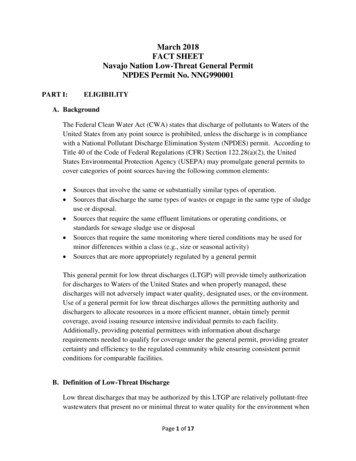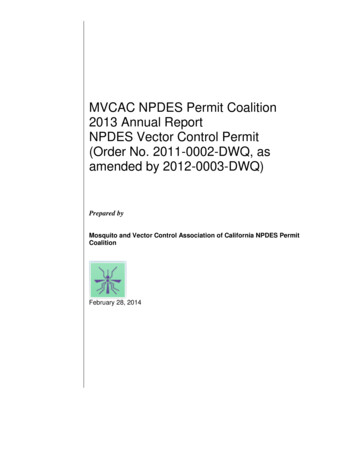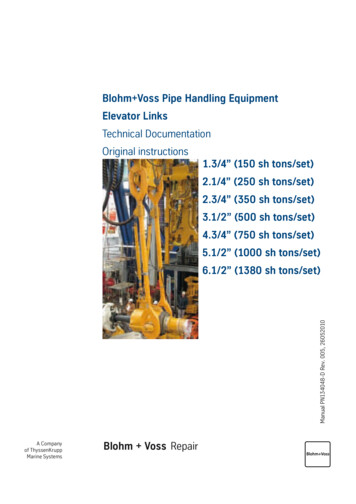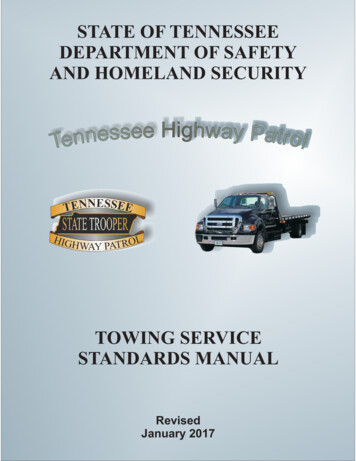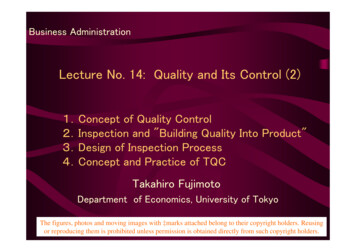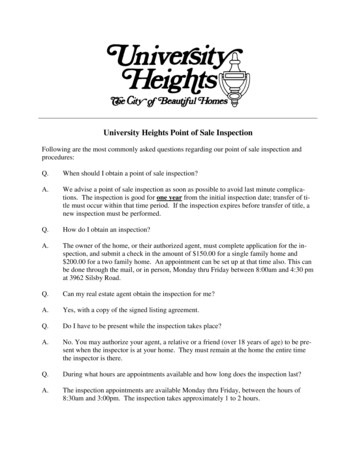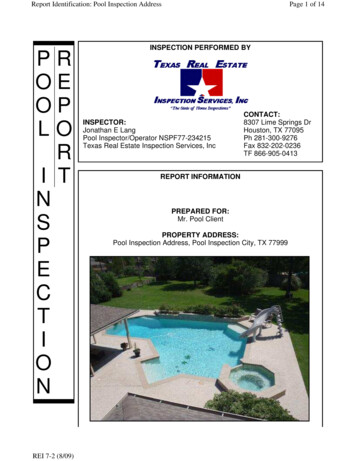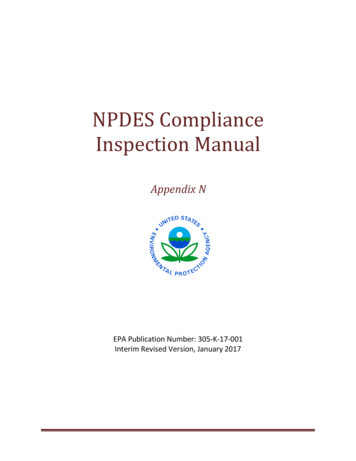
Transcription
NPDES ComplianceInspection ManualAppendix NEPA Publication Number: 305-K-17-001Interim Revised Version, January 2017
U.S. EPA Interim Revised NPDES Inspection Manual 2017Appendix N –Updated Fact Sheet: Department ofTransportation Hazardous MaterialsAppendix N – Page 581
U.S. EPA Interim Revised NPDES Inspection Manual 2017DEPARTMENT OF TRANSPORTATION HAZARDOUS MATERIALS TRAININGWhat are DOT training requirements?DOT’s training requirements can be found at 49 CFR Part 172, Subpart H. In general, anyemployee who has a responsibility working with hazardous materials (hazmat) that is placed incommerce must have hazmat training. The employee must be familiar or aware of therequirements enabling the employee to recognize and identify hazardous materials, i.e.,hazardous samples vs. non- hazardous samples, consistent with the hazard communicationstandards. The training must be commensurate with functions and responsibilities of theemployee.Why does hazmat training apply to me?As an inspector, you are likely to be a hazmat employee because you collect samples during aninspection and prepare the hazmat samples for transportation. The EPA is a hazmat employerbecause the Agency causes hazmat to be transported or shipped in commerce through itsemployees. DOT defines "hazmat employer" to include any department, agency, orinstrumentality of the United States, a State, a political subdivision of a State, or an IndianNation. Administrative and secretarial staff are also subject to DOT training if theirresponsibilities cause hazmat materials to be placed into commerce, i.e., preparing shippingpapers.Does my EPA training substitute for DOT training requirements?The EPA Health & Safety course provides the inspector with information on protecting oneselffor on-the-job hazards and would meet DOT’s Safety training requirement. It does not meet theGeneral awareness/familiarization requirement. See DOT’s training requirements.What type of DOT training do I need?DOT hazmat training is function-specific. For most inspectors, the general awareness hazardousmaterials training course found on the DOT’s website will be sufficient to meet the DOT trainingrequirements. Alternatively, the employer can provide function specific training from othersources. (see below).What are DOT’s training requirements for hazardous materials?DOT’s hazmat training, 49 CFR Part 172.704, focuses on three requirements applicable toinspectors and administrative staff: General awareness/familiarization Each hazmat employee shall be provided general awareness/familiarization trainingdesigned to provide familiarity with the hazmat requirements and to enable theemployee to recognize and identify hazardous materials consistent with the hazardcommunication standards.What are DOT’s requirements for hazardous materials? Function-specificAppendix N – Page 582
U.S. EPA Interim Revised NPDES Inspection Manual 2017 Each hazmat employee shall be provided function-specific training as it applies tothe employee’s job responsibilities. Safety Emergency response information required by part 172, subpart G, i.e., informationthat can be used in the mitigation of an incident involving hazardous materials;Measures to protect the employee from the hazards associated with hazardousmaterials to which they may be exposed in the work place, including specificmeasures the hazmat employer has implemented to protect employees fromexposure; and Methods and procedures for avoiding accidents, such as the properprocedures for handling packages containing hazardous materials.Where can I find training opportunities?A good training resource is DOT’s hazmat page, hazmat.dot.gov/training. You can download theinstructor’s and student’s training manual for in-house use. The training manual does includetest questions. Self-training is acceptable by DOT so long as 49 CFR Part 172.704 trainingrequirements are met. The DOT’s Transportation Safety Institute in Oklahoma City, OK offerstraining on-site. Course dates are available from the website.In addition to DOT’s hazmat site, this web link, hazmat.dot.gov/thirdpty.htm identifies thirdparty providers who offer a variety of hazmat training courses.How long does the certification last?The hazardous materials training is required to be completed within the first 90 days ofemployment. The certification period is good for three years and then the hazardous materialstraining program must be retaken. If your job responsibilities change, your training needs maychange.Who is responsible for training?The employer is responsible. DOT’s definition of employer is not clear in terms of EPA’sadministrative structure. “Employer” could be defined as the Administrator or any othermanager in direct supervisory line of the employee.Who is responsible for keeping the training record?The employer is responsible for keeping the employee’s records.What should be in the training record?Documentation that shows the employee has completed the necessary training, and has beentested and certified.Specifically, what documents need to be retained?A record of current training, inclusive of the preceding three years must be retained for as longas the employee is employed by that employer as a hazmat employee and for 90 daysthereafter. The record shall include the following information:(1)(2)The inspector's name;The most recent training completion date of the inspector’s training;Appendix N – Page 583
U.S. EPA Interim Revised NPDES Inspection Manual 2017(3)(4)(5)A description, copy, or the location of the training materials used to meet therequirements;The name and address of the person providing the training; andCertification that the hazmat employee has been trained and tested.Does the employee have to “pass” the test?The requirements do not state that the employee must "pass" a test; however, an employeemay only be certified in areas in which he/she can successfully perform their hazmat duties.Know Your Shipper’s Requirements!Before collecting samples, know which shipping company you will be using to ship yoursamples. Some require additional training and certification beyond the basic DOT requirements.Here are three common carriers with some of their requirements for shipping hazmatmaterials.Federal Express (FedEx)The shipping method you select determines what type of training FedEx expects you to havecompleted. If you plan to ship samples by ground, the DOT training requirements are sufficient.If you plan to ship the samples by air, then you must be trained according to International AirTransport Association (IATA) regulations. Successful completion of the IATA requirements willmeet DOT’s hazard communications requirements. IATA training and information can be foundat: www.iata.org.United Postal Service (UPS)Documentation that shows the employee has awareness training is acceptable by UPS forground shipments. Shipments by air require IATA training.United States Postal Service (USPS)DOT’s general awareness training and testing is acceptable by USPS for both shipping by groundand air. However, the Postal Service does have limits which are more stringent than DOT’sregulations. Check this website for further details - http://pe.usps.gov/text/dmm/c023.htmBefore shipping, you should inquire with the shipping company if they have additionalrequirements for handling, packaging and shipment limitations for the hazmat materials.Here are a few issues an inspector may face with the different shippers: Do you want them to meet you at the site? You may need to call ahead to schedulethe pickup before you arrive at the site to collect samples. Do you plan on dropping the shipment off? Not all offices can accept dangerousgoods and hazmat. Shipping papers may need to be typed, not handwritten. Do you bring a portabletypewriter with you or type the shipping papers before leaving the office?Appendix N – Page 584
DOT's training requirements can be found at 49 CFR Part 172, Subpart H. In general, any employee who has a responsibility working with hazardous materials (hazmat) that is placed in . Self-training is acceptable by DOT so long as 49 CFR Part 172.704 training requirements are met. The DOT's Transportation Safety Institute in Oklahoma City .
